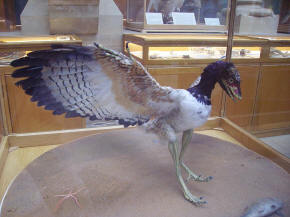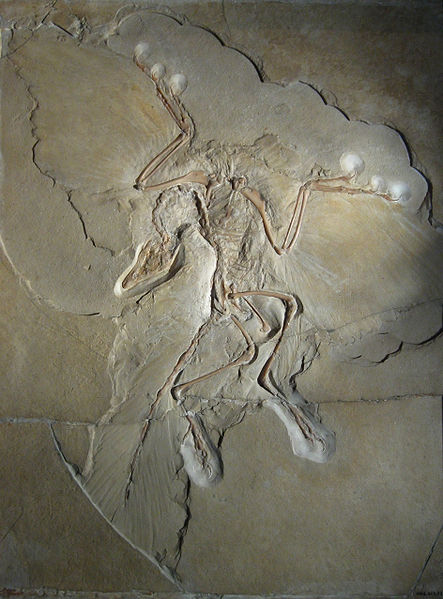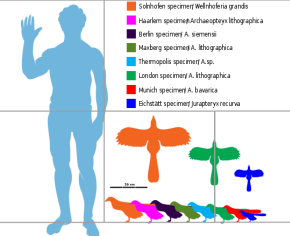|
The features above make Archaeopteryx a clear candidate
for a
transitional fossil
between dinosaurs and birds. Transitional fossils are supposed to
indicate evolution from one species into another. For Christians, this
is a matter of debate. Many old earth creationists believe God created
the species with the process of evolution, whereas believe God created each
species as a unique individual, not evolved from other species.
Whatever form of old earth creationism you believe in, Archaeopteryx remains
an example of one of the oldest birds in the fossil record.
Archaeopteryx plays an important role not
only in the study of the origin of birds but in the study of dinosaurs.
The first complete specimen of Archaeopteryx was announced in 1861, only two
years after Charles Darwin published On the Origin of Species, and it became
a key piece of evidence in the debate over evolution.
Archaeopteryx seemed
to confirm Darwin's theories and has since become a key piece of evidence in
the origin of birds and transitional fossils debate. Indeed, further
research on dinosaurs from the
Gobi Desert and
China has since
provided more evidence of a link between
Archaeopteryx and the dinosaurs, such as the
Chinese
feathered dinosaurs.
Archaeopteryx
is close to the ancestry of modern birds, and it shows most of the features
one would expect in an ancestral bird. However, it may not be the direct
ancestor of living birds, and it is uncertain how much evolutionary
divergence was already present among other birds at the time.
The only
specimens of Archaeopteryx
that have been discovered come from the
Solnhofen limestone in
Bavaria, southern Germany, which is a
lagerstätte, a rare
and remarkable geological formation known for its superbly detailed fossils.
Over the years, nine more fossils of Archaeopteryx have surfaced. Despite
variation among these fossils, most experts regard all the remains that have
been discovered as belonging to a single species, though this is still
debated.
Many of these eleven fossils include impressions of
feathers—among the oldest (if not the oldest) direct evidence of feathers.
Moreover, because these feathers are an advanced form (flight
feathers), these fossils are evidence that
feathers had been evolving for quite some
time.
Paleoecology
The
richness and diversity of the
Solnhofen limestones in
which all specimens of
 |
| Museum rendition of what Archaeopteryx may have looked like (Picture
Source) |
Archaeopteryx
have been found have shed light on an ancient Jurassic Bavaria strikingly
different from the present day. The latitude was similar to Florida, though
the climate was likely to have been drier, as evidenced by fossils of plants
with adaptations for arid conditions and lack of terrestrial sediments
characteristic of rivers. Evidence of plants, though scarce, include
cycads and conifers
while animals found include a large number of insects, small lizards,
pterosaurs and
Compsognathus.
The
excellent preservation of Archaeopteryx
fossils and other terrestrial fossils found at Solnhofen indicates that they
did not travel far before becoming preserved. The
Archaeopteryx specimens
found are likely therefore to have lived on the low islands surrounding the
Solnhofen lagoon rather than been corpses that drifted in from farther away.
Archaeopteryx
skeletons are considerably less numerous in the deposits of Solnhofen than
those of pterosaurs, of which seven genera have been found. The islands that
surrounded the Solnhofen lagoon were low lying, semi-arid and sub-tropical
with a long
dry season and little
rain. The closest modern analogue for the Solnhofn conditions is said to be
Orca Basin in the
northern
Gulf of Mexico, though
that is much deeper than the Solnhofn lagoons. The
flora of these islands
was adapted to these dry conditions and consisted mostly of low (3 m
[10 ft]) shrubs. Contrary to reconstructions of
Archaeopteryx climbing
large trees, these seem to have been mostly absent from the islands; few
trunks have been found in the sediments and fossilized tree
pollen is also absent.
The
lifestyle of Archaeopteryx
is difficult to reconstruct and there are several theories regarding it.
Some researchers suggest that it was primarily adapted to life on the
ground, while other researchers suggest that it was principally arboreal.
The absence of trees does not preclude
Archaeopteryx from an arboreal lifestyle;
several species of extant bird live exclusively in low shrubs. Various
aspects of the morphology of Archaeopteryx
point to either an arboreal or ground existence, the length of its legs, the
elongation in its feet; and some authorities consider it likely to have been
a generalist capable of feeding in both shrubs, open ground and even
alongside the shores of the lagoon. It most likely hunted small prey,
seizing it with its jaws if it was small enough or with its claws if it was
larger.

Return to the
Old Earth Ministries Online Earth
History Curriculum homepage.
Source:
Archaeopteryx
|


